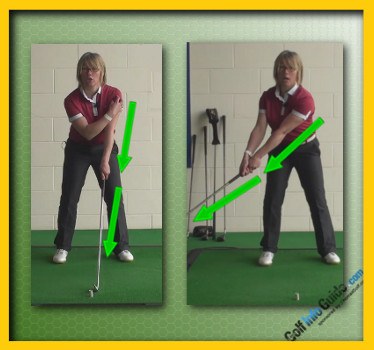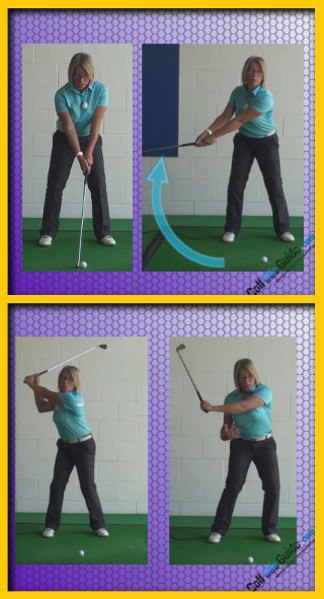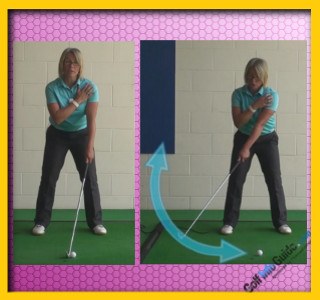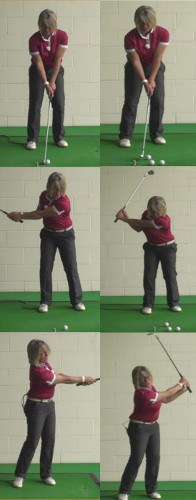Lady golfers need to generate as much power and club head speed as possible during their golf swing to maximize the distance that they can hit the golf ball.
Unlike men, ladies do not have the brute strength in their bodies to muscle the ball down the fairway. Technique becomes even more crucial to lady golfers if they wish to achieve distance with their golf shots.

One of the most important areas of technique for any lady golfer is to ensure that their left arm remains constantly straight from set up, throughout the backswing, at the top of the backswing and then during the downswing and into impact. By maintaining this straight left arm position throughout both the backswing and downswing you will achieve the widest possible arc for the club head to swing around. In simple terms, the straighter you keep the left arm, the more you are keeping the club head away from your body and the further the club head is away from your body, the bigger the circle it creates around you as it moves. Creating a big or wide arc with your swing enables you to have more time to build up speed in the club head as you swing it and the more speed that the club head has, the further you will hit the ball.
Keeping your left arm straight is also really important in allowing you to consistently produce good solid strikes from the middle of the club face. As you start your golf swing, your left arm should be straight and this sets the distance between your shoulders and the ball. As you swing away from the ball, if you bend your left arm at any point, you are shortening the distance between your shoulders and the club head. As you return the club head back down to strike the ball, if you do not straighten your left arm back out, you will hit the top of the ball. But having to straighten your left arm whilst you are swinging the club at full speed requires a lot of timing, and under pressure, this will show up and you will become inconsistent, sometimes timing the straightening of the left arm and striking the ball well and other times not quite managing to straighten the arm and hitting the top of the ball.
We see the best players in the game today demonstrating a very straight left arm look through the impact position, helping them to deliver a consistent club head height back to the ball and to deliver club head speed, so the easiest way to achieve this is to start with your left arm straight, swing back with your left arm straight and then return back to the ball with your left arm straight!
To achieve this position, straighten your left arm whilst at address before you swing the club. Work on achieving a really straight line from your left shoulder (if you are a right handed player) down to your left hand and then down the shaft of the golf club to the club head. Keep these three positions in line as you begin your backswing and once the club head is approximately two inches to the right of the ball on your backswing, begin to hinge your wrist.
Failing to hinge your wrist correctly is the main reason you will struggle to maintain a straight left arm position during your backswing. If you fail to hinge your wrist appropriately you will start to lift the club up with your arms and this action will cause the left elbow to buckle at the top of the backswing due to the momentum of the club swinging over you. It is essential to hinge your wrist at the end of your takeaway as this will allow you to keep your left arm straight. Work on pushing your hands away from your body as you reach the end of your backswing, rather than pulling your hands in towards you. If you are not sure how it feels to move your left arm in this way, try the following drill.
Take some resistance tubing and place it under your left foot. Hold the tubing as though you are holding your golf club and make sure there is a little slack in the tubing. Make a backswing movement and stretch the tubing away from your body - hold it out from your body and to your right. This is the position to work on achieving the feel for your left arm, during your backswing.
Alternatively if you find this difficult, try taking an empty plastic bottle that you can cut either end off and place this over your left arm and elbow. This will straighten your left elbow and you can make a backswing to get the feeling of how to hinge your wrists and keep your left arm straight. But please DO NOT swing through if you are trying this, this is only for your backswing and back to impact, as your left elbow needs to bend during your follow through, so do not swing at speed and into your follow through!
Work on these drills and you will be keeping your left arm much straighter during your golf swing, creating a big arc for the club head to travel on allowing you to gain more speed in the club head and deliver it back to the ball more consistently.

Why and How Should Golfers Keep Their Left Arm Straight?
If you have played golf for any period of time, you know one thing to be true – no two golf swings are exactly alike. You could stand out on the tee line of your local driving range all day long and never see two swings that are exactly the same. With that said, there are elements within those swings that are the same from player to player, and for good reason. While there is plenty of room for individuality within the golf swing, some of the fundamentals of this game apply to all players across the board. Such is the case with the position of your left arm in the swing. If you are a right handed golfer, you should be working to keep your left arm straight from the time the swing begins until it folds up on the way into the finish.
Of course, even within basic fundamentals such as the position of the left arm, you are going to see exceptions from time to time. For instance, Jordan Spieth allows his left arm to flex during the backswing, and he is one of the very best golfers in the world. However, you shouldn't be distracted by the rare exception to the rule. For the vast majority of golfers, the best course of action is to keep the left arm straight throughout the swing. In this article, we will take a closer look at why a straight left arm is going to help your swing, and exactly how you can make it happen.
Before you get too far into the instructional portion of this article, you should take a moment to figure out how you are using your left arm in the golf swing currently. Are you allowing the arm to flex in the backswing or downswing, or is it already staying straight all the way through the ball? If you are currently keeping your arm straight, it may be that you don't need to make many changes to your swing with regard to this point. You can still read through the rest of the article for informational purposes, of course, but your work may have already been done. If you find that you are flexing your arm, however, don't wait any longer to improve this part of your technique. Everything from power to accuracy and more can be improved when you swing with a straight left arm, but those improvements are only going to come through practice. Spend time at the range working on what you learn below and your swing will be on the fast track toward a better future.
All of the content below is based on a right handed golfer. If you happen to play left handed, please take a moment to reverse the directions as necessary.

Advantages of a Straight Left Arm
You should never make any changes to your golf swing without first knowing exactly how those changes stand to benefit your performance. Golf is hard enough as it is – you don't need to make it harder by making changes just for the sake of change. Think through any change that you are going to make to your technique and only put it into action if you are sure it is the right move for your game as a whole.
With that concept in mind, we need to get this article started by highlighting some of the many advantages of playing with a straight left arm. The list below is not meant to be an exhaustive collection of everything that a straight left arm can do for your swing, but it is a good place to start.
- Extension: Perhaps the most important thing that a straight left arm will bring to your game is added extension in the backswing. You need width to create power in golf, and a straight left arm is going to give you the width you are looking for. Think about it this way – if you want the club to be as far away from your head as possible at the top of the swing, how are you going to make that happen? By keeping your left arm straight, of course. By definition, the club is going to be in closer to your body if you bend the left arm, meaning your swing will be narrower and less powerful. Great extension gives you time to build speed from the top of the swing on down through impact, so straighten out that left arm and maximize the length of your swing path to the greatest possible extent.
- Stability and consistency: As you already know, one of the most difficult things to do in golf is to hit the ball solidly time after time. Sure, you can probably run into a solid shot now and then, but producing those solid shots hole after hole, day after day, is another matter entirely. If you are going to shoot low scores, you need to be consistent with the quality of your ball striking. To add consistency, work on using a straight left arm to trace the same path with all of your swing. When you bend the left arm, you will basically be adding a variable that doesn't need to be in your swing. Sometimes that bend will be predictable and consistent, where other times it will be harder to gauge. In the end, the best way to keep your swing performing at the same level time after time is to hold your left arm straight.
- Simplicity: Golf, by nature, is a complicated game. With that in mind, you want to do everything you can to make the game as simple as possible. Taking moving parts out of your swing is one way you can simplify the challenge of making a great swing. When your left arm stays straight, that is exactly what you are doing. The left arm won't be bending during the backswing or downswing, so you don't have to worry about performing that part of your swing correctly. There are other challenges in the swing to be sure, but you can check this point off of your list before even starting.
As you can see, there are some pretty major advantages to be enjoyed when you keep your left arm straight. Are you going to automatically hit great shots just by straightening your left arm? Of course not. However, this is a big step in the right direction, and it will take you closer to what would be considered a 'professional' type of golf swing. Once you are confident in the performance of your left arm during the swing, you will be able to move on to other points which will take you closer to the well-rounded action you need to post great scores.

Setting Up Straight
The best way to make sure your left arm stays straight during the backswing and downswing is to set up with it straight to begin with. At address, you want to have your left arm hanging straight down from the shoulder, with no flex in the elbow. The arm doesn't need to feel like it is 'locked out' – there shouldn't be any tension in the arm – but it does need to be straight. As you complete your grip on the club, there will naturally be a bit of bend in your right elbow as your left stays straight. This is perfect. With a straight left arm and a slightly flexed right, you will be well-prepared to make a quality backswing.
Of course, putting your left arm in a straight position is just one of the many things that you need to do right in your setup. Some of the other key setup points for you to check on at address are listed below.
- Flexed knees: Although your left arm should be straight, your legs most certainly should not be. Instead, they should be flexed equally, placing you in a slightly 'seated' position that engages the big muscles of your legs before the swing even begins. This is a point that many amateur golfers get wrong, so be sure to check on the positioning of your lower body before moving on to other pieces of the puzzle. With flexed legs, you will be able to support the rotation both back and through that is going to take place in your upper body during the swing.
- Flat back: Speaking of rotation, it is difficult to rotate properly if your back is not in the proper position. Once you have sat into your lower body slightly, make sure that your back is flat all the way from your waist up into your neck. A flat back position is going to make it much easier to turn as you swing, and rotation is the key to success in golf. Most people feel like their backside is sticking out behind them when they take a good stance with a flat back, so that is a sensation you can use to guide your positioning.
- Chin up: This is the point that is most often overlooked in the stance, yet it is one that is crucially important to your success. As you stand over the ball, you want to make sure that your chin is up and away from your chest. This is a key point for one very specific reason – your shoulders need room to turn back and through the shot. When your chin is pushed down into your chest, there will be no path for your shoulders to turn. As a result, you may be forced to come up and out of your stance at some point. Don't make that mistake. Lift your chin up away from your chest, keep your eyes down on the ball, and make a great turn.
There are few things that are as important to your success on the golf course as building a quality stance. If you start from a good position, the rest of the swing immediately gets easier. This is something that professional golfers understand, as they spend countless hours simply working on their stances. Unfortunately, amateur players don't seem to have the same level of appreciation or understanding for this important point. If you would like to find a way to stand out from your competition at the local club, make sure you work hard on your stance. It might not be the most exciting thing you do at the golf course, but it is sure to have a lasting impact on your game.
Also, as it relates specifically to this article, you will find it much easier to make a quality swing with a straight left arm if you have started from a good stance. With your left arm straight at address, and with the rest of your address points checked off as well, you will notice things quickly starting to fall into place.

Making the Swing
So, with the stance completed and ready to go, there is only one thing left to do – swing the club. As long as you have done everything right up until this point, the swing should actually be the easy part. You have laid the groundwork for a solid swinging action, and now you get to see the fruits of your labor. In a lot of ways, the only thing you have to do during the swing is to make sure that nothing goes wrong. Unless you make a major mistake in one fashion or another, you should be all set to see the ball sail beautifully toward your target.
Sadly, there is a lot that can go wrong during the swing, so you are going to have to practice your technique before heading out to the course if you want to see quality results. To make sure that your left arm makes it from the start of the backswing all the way through impact in a straight position, check out the tips provided below.
- Start slow. This is one of the best tips you can receive in the game of golf. No matter what kind of shot you are trying to hit, your swing should start slowly and build speed gradually as it develops. This applies whether you are hitting a long tee shot with a driver or a short approach with a wedge. By starting your swing slow, your body will be able to keep up with your arm swing, and everything will stay nicely 'connected'. It is easy to rush your swing as you get in a hurry to see where the ball is going to go, but you are going to need to avoid that trap if you wish to play well. When you start slow in the takeaway, your left arm will have an easier time staying straight because your elbow won't need to bend in order to keep up with the rest of your movements. Keep the arm straight, allow your takeaway to build slowly, and be patient in waiting for impact to arrive.
- Make a full turn. This is likely the point where most amateur golfers lose track of their ability to keep the left arm straight. A great shoulder turn is important in a number of ways, but one of its biggest benefits is allowing you to keep your left arm straight while still getting the club all the way back. If you were to cut your shoulder turn short, your straight left arm would not be able to wrap the club around your back as necessary in the backswing. So, as a result, it is likely that your arm would bend to force the club back into position. It should go without saying that this is an undesirable way to move the club. Instead, make sure your left shoulder is turning at least under your chin on the way back, if not farther. When you swing this way, your left arm can stay straight without any problem, and the club will be far enough back to create a powerful downswing. If you start to notice problems with your swing when out on the course, check on this problem first – many golfers cut their turn short on the course, and it costs them in a big way.
- Don't help the ball. One last problem that you can have during your swing is trying to help the ball into the air. If you try to help the ball get up off the ground at impact, it is likely that your left arm will bend in an effort to add loft to the club. This is, of course, unnecessary. The club you have selected should already have the right amount of loft for the shot, so it is not necessary to help the ball up by adding loft at impact. Simply swing through the ball aggressively and with confidence, and everything else should take care of itself.
The golf swing is a complicated action to be sure, but the left arm doesn't need to do anything complex during the swing. In fact, keeping its action simple and repeatable is the best way to go. If you are able to keep your left arm straight throughout your swing (until you get into the follow through, of course), you will likely love the results that you see on the course.

Left Arm in the Short Game
With all of the talk above about how the left arm should behave in the full swing, it seems appropriate to touch briefly on how that same arm should work in the short game. There are two different topics of discussion here – putting, and chipping. We will deal with each of those separately below.
- Putting: When putting, you want to allow your left arm to be slightly flexed at address. This softer position will allow you to have a better feel for the club head as you putt, which is crucial to your success. However, while the elbow is going to be slightly flexed at address, it is not going to bend or straighten at all during the stroke. It is important that you keep that joint as stable as possible while rolling the ball toward the hole if you want to see success on the greens. Just as in the full swing, repeating your action time after time is key to putting well. So, once you get set in a comfortable position over the ball with your putter in hand, hold that position steady and just rock your shoulders back and forth in order to stroke the putt.
- Chipping: Moving on to chipping, here you are going to see a technique that is very much similar to what you used in your full swing. You are going to set up with your left arm in a straight position, and you are going to keep it that way throughout the shot. There is no need to flex your elbow at any point while chipping, and doing so will only make it harder to strike the ball cleanly. While your shoulders are going to play an important role in your chipping action, you also want to be sure to get your wrists involved slightly as well. Allow your wrists to hinge a bit during your backswing, and then use that hinge to hit down into the ball at impact. When you blend a straight left arm position with the right wrist action, it is possible to create accurate and controlled chip shots time after time.
Your left arm plays a vital role in the success of your golf swing. As you now understand, it is helpful to keep that left arm as straight as you can throughout the swing, as that simple fundamental is going to make it easier for you to strike the ball cleanly on a consistent basis. Consistency is something that is always hard to find in this challenging game, but your left arm can help you move in the right direction on that point. Good luck and play well!






